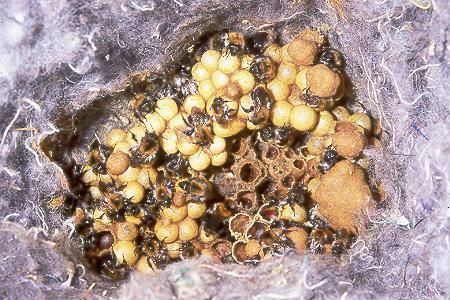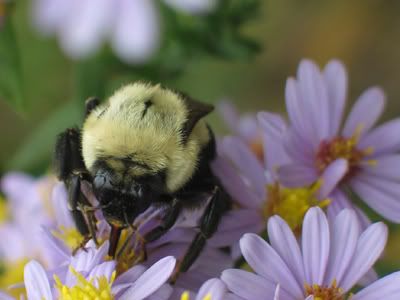Wednesday, October 13, 2004
Plight of a bumble bee, Part III
You may remember that the last post in this series lamented the death of a queen bumble bee and promised to show what may have been. So we’ll pick up the story by explaining what will be happening around me as emergent queens get fed and establish a new nest.
The inside of a bumble bee nest

An worker bumblebee taking nectar from some daisies
Earlier I indulged in a rather purple passage comparing the life cycle of a bumble bee nest with denizens of some doomed planet. They also remind me of some of my father’s wisdom so if you’ll allow me another digression I’ll explain it.
I grew up on a plant nursery specialising in “showy” annuals like pansies and petunias, Dad was always amused by the idea held by many gardeners that perennial plants like roses that survived the winter were somehow more ‘refined’ than the ephemeral flowers he sold. The way he saw it annuals had developed a much more elegant solution to the problem of winter, rather than dieing back ever year they spend all summer saving up to put all their efforts into seeds that will survive the cold weather and grow into new plants carrying their parent genes into a new season. I find the idea of hibernating queens lying like seeds under the soil waiting for the warm touch of spring to set off the events that will ensure another summer will be filled with the bumble bee’s buzzing baritone extraordinarily beautiful.
That ends this series of posts but I thought I should point out a few references to works that have proved invaluable in my investigation of the world of bumble bees. In order to generate a clear and I hope concise picture of the bumble bee’s life cycle I have often glossed over interesting points and been a little overly reductionist in my description, if you’ve been interested in the story then I urge to find out more.
The book “The Natural History of Bumblebees: a Sourcebook for Investigations” by Carol Kearns and James Thomson is a great resource. It contains enough information for an enthusiastic layman to get a good grasp of bumble bee biology and includes a “photographic filed guide” to American bumble bees for next summer. If you become utterly obsessed with bumble bees the book describes how to raise a nest by catching a queen before she established her own and how to use that nest to conduct simple experiments.
4 Comments:
hermes birkin bag
ugg boots
cavaliers jerseys
ray ban sunglasses
cheap ugg boots
cheap cartier watches
nike outlet
louis vuitton borse
michael kors handbags
coach outlet
louis vuitton outlet stores
gucci outlet online
louboutin pas cher
prada sunglasses
ugg outlet
ugg uk
ugg uk
ugg boots sale
nike roshe one
uggs sale
hollister jeans
coach factory outlet
polo ralph lauren
louis vuitton purses
adidas yeezy boost
michael kors handbags
mont blanc pens cheap
coach factory outlet online
chenyingying2016912












